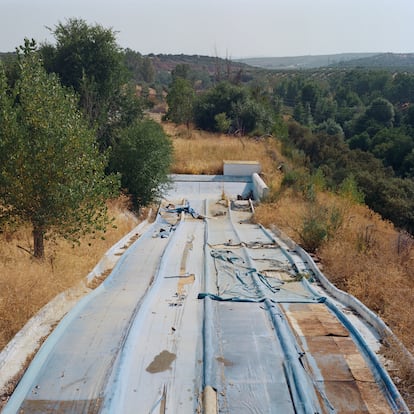Images of abandoned aquatic parks from European countries, the United States or Japan, truffled with old postcards that show the success of the public they had. Photos with a dreamlike, pop, dystopian point, of absurd violence that they do not judge, but indicate a range of contemporary songs and debates. Popular tourism, the summer climb, memories, the leisure of payment with global formats, the waste of water, the consumption of territory of using and throwing of voracious capitalism, the municipalities that today authorize activities that tomorrow forget. The architect and photographer Pol Viladoms has just published Aftersun (Possible editions), a photo book of abandoned aquatic parks that he has taken in an amazing trip that began in 2009 “casual”, when he encountered, returning from the beach, with the remains of the old Aquatic Paradise de Sitges (Barcelona).
Viladoms was attracted to the symbiosis between the pools, slides and trampolines and the nature that was taking them. Sitges’ park occupied part of a hill and the space “hooked”: “The vegetation that hugged the functional structures, the fantasy idea of ancient spaces designed to evade and move to another world,” he evokes. The question was then “if it was an isolated case or had been replicated elsewhere.” He searched in press, archives, internet … and until today. For the first photos he chose black and white, but the project has ended up being in color. With trips between 2010 and 2025, the images are taken with a mid -square film format camera, a Hasselblad, those with a superior viewfinder that photographers support the body. He has ruled out the photos of vandalized or graffiti parks: he chose to capture the passage of time without alterations.
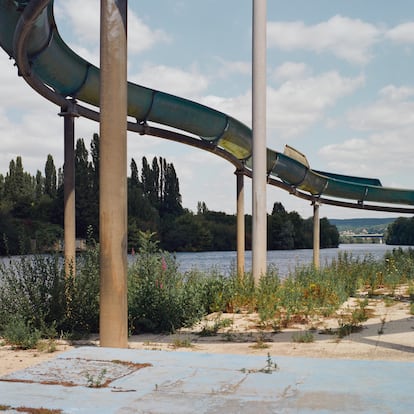
The visits to the parks always had “a surprise factor.” Some have already been dismantled, others are very destroyed after being occupied, sometimes it costs to see the pools because they are hidden, in some cases it found people living in the constructions that are still standing, such as showers or lockers, evokes the photographer and architect. In total, he was in 50 locations from Spain, Italy, Greece, Portugal, France, the United States and Japan. “Very crazy trips” that he did alone, with friends or as a couple.
The idea of incorporating old postcards of aquatic parks and confronting them with the photos of the ruins arose during the incursions: “He found everything: souvenirs, Postcards, flip flops, towels, advertising, entries … “, remember fun.” The postcards were for me old images of a past that no longer exists, when going to a pool to have fun was an experience. “And they also point out the value they had:” What deserves to be remembered with a ‘I was here’, although the parks have not been given importance. ”
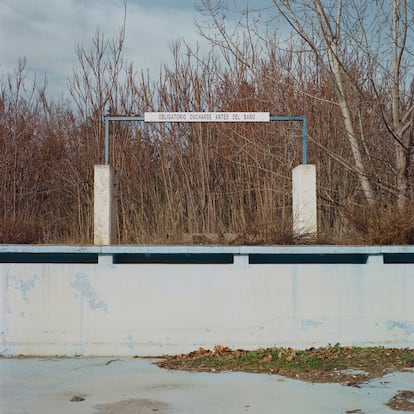
By scanning them in high resolution, the photographer realized “the sub -strokes containing.” The queues, the Chulopiscins At the top of the trampolines, the somersaults, the desihibition when lower voyeurof the 10×15 centimeters postcards extended squares of a single centimeter and appeared “the intimate image of a reconstructed memory, perhaps cheater, which you do not remember accurately.” For years, he looked for parks postcards in markets, and found jewels like this: “Dear family, I greet you from this paradisiacal place, where I am spending my vacation in the company of a large group of friends. Many memories to all, Ricardo.”
Of Aftersun It is striking that the photos do not bear foot. The location, the name of the park or the date is not known. “I liked the idea that you do not know where they are to read as a continuum, as if it were a single location, because the phenomenon of aquatic parks is global. The ruins are ruins, no matter where each one is, what you see is identifiable with any park, they are standardized, closed spaces, with the same standards.” “As a photographer I am interested in leaving it open, I like spaces, in this case they represent a past and a fleeting present, and they have many readings,” he says. To what adds to a “dialogue between two worlds: the photos and the postcards, present and past, empty and full, reality and memory.”
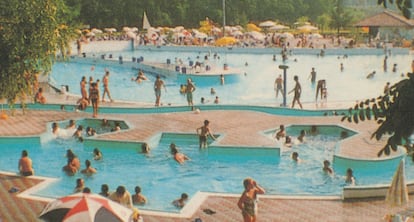
As far as the author has learned, the closure of the parks he has portrayed occurred after serious accidents or due to lack of public, competition from other spaces or in fallen tourist areas in disgrace. Among the Spanish enclosures that appear is the aforementioned Sitges, Aquaoliva in Jaén, Aquopolis in Madrid and Turbogán in Alcossebre (Castelló). The only text of Aftersun They are two pages signed by the commissioner and cultural manager Beatriz Escudero.
The POL Viladoms project will be exhibited during the Tarragona Scan Photography Festival, in autumn. About the title, he clarifies that he called Aftersun to the project before the multipremized 2022 British film vintage. The photographer explains that most are made at noon, with short shadows. “It was important to shoot with the same film so that the tones were similar, especially since the locations are in different countries, and I tried that the light of the skies was also similar.” The Hassel who used, he adds, was from his father, who gave it to her.
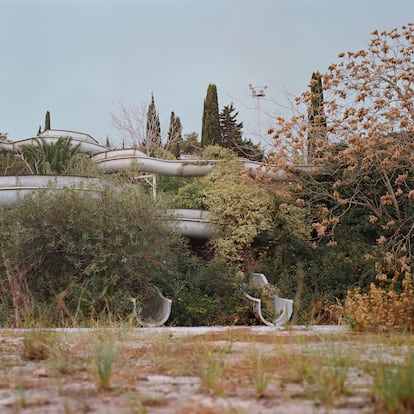
About abandoned aquatic parks also speaks a recent artistic project, End of the season, of actress and architect Leonor Martín and the architects Aida Navarro and Alejandro Sánchez, who since 2020 are visiting closed enclosures in the Iberian Peninsula and questioning their economic and environmental sustainability. Contemporary ruins are a very sexy raw material from the photographic point of view. An attraction that invites you to investigate its why, whether from art, anthropology, economy, urbanism or any other discipline.
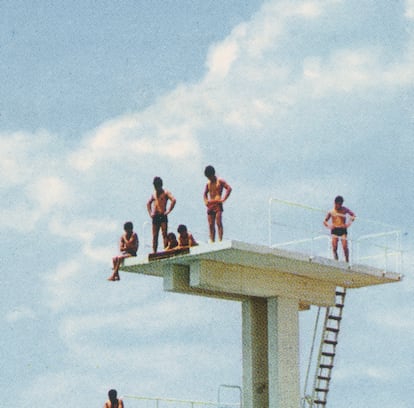
Modern ruins, a profit topography It was called the project of also the architect and photographer Julia Schulz-Urdnburg, published by àmbit in 2012, which gives an account of abandoned urbanizations with images that exploded the head. Ski slopes attached to a town of one hundred inhabitants of Valladolid. A mountain of apartments next to a golf course that did not work, in Almería. Cement orgies. Witnesses of the hangover party in Spain that the author toured for two years. An inheritance in the form of brick scars that invites to be revisited now when, as then after the bubble explodes, the housing crisis is again the main issue of social debate.

